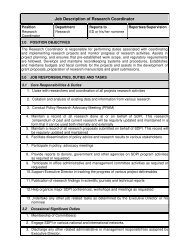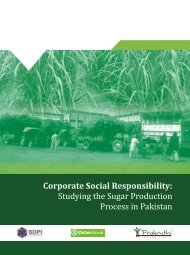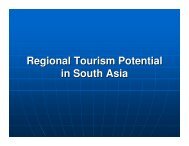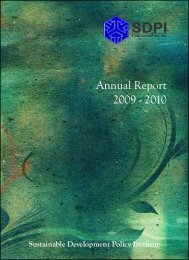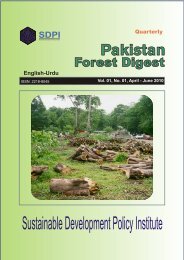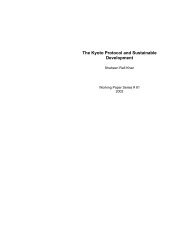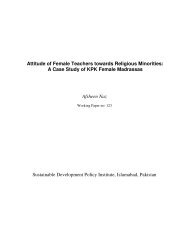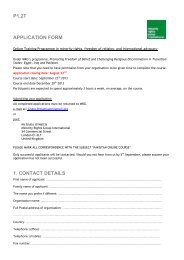Setting Context By Imran Sikandar Baloch - Sustainable ...
Setting Context By Imran Sikandar Baloch - Sustainable ...
Setting Context By Imran Sikandar Baloch - Sustainable ...
Create successful ePaper yourself
Turn your PDF publications into a flip-book with our unique Google optimized e-Paper software.
TheoreticalActorsLearningDiscussionFrameworkand ExamplesICTs and Women Empowerment –Key Actors• Private Sector :– The information revolution owes its origins to the private sector.– They are vendors and manufacturers of hardware as well as the software.– Exercise significant influence in the ICTs sector.• Governments:– Governments see ICTs as a private sector led arena except limited focus in the e‐governance.– Only recently have some governments realised the potential of ICTs as a medium of social change.• International Organisations:– UN , WSIS , ITU , UNICEF, UNIFEM• Civil Society :– At the fore front of the ICTs and gender debate.
TheoreticalActorsLearningDiscussionFrameworkand ExamplesCase Studies – Morroccon Women Weavers.• Target Group :– Women rug weavers in two remote villages in Morrocco.• The Challenge :– Incorrect stereotypical roles of women in Muslim countries as conceived by the west.– Poor, illeterate women can not use internet so could not display their products to the world.• The Process :– Dr.Susan Schaefer Davis created a website for displaying the rugs along with estimated prices ( as demanded by theweavers).– Employed intermediary female assistants who could work on computers, talk to the community and workout basictransactions.• Benefits :– Empowerment of the female assistants who gained a respectable status in the society.– Economic and social empowerment of the weavers who earned money to sustain their families.– Weavers in one location even donated a part of their money to a local school.
TheoreticalActorsLearningDiscussionFrameworkand ExamplesCase Study – Afghanistan’s Sada• Target Group :– Illiterate women in rural Afghanistan.• The Challenge :– Target women who are ‘oral communicators’.– Motivate them to vote for the parliamentary elections.• The Process :– Special pink coloured easy to navigate mp3 like audio players.– The player contained contents on religion, society, election and culture in local languages.• The Benefits :– The device reached more than 20000 women.– 95 % of the women said they learned new information regarding Afghanistan and democracy.
TheoreticalActorsLearningDiscussionFrameworkand ExamplesCase Study – Bangladesh’s Pallitathya Help Line• Target Group :– Illiterate women in rural Bangladesh, who do not have access to basic legal, medical and general information.• The Challenge :– Deprived of information the women are dependent upon superstition and men in the family for information.• The Process :– D.Net established a Help Desk and developed content in local language regarding general use information.– Mobile ladies were deputed in the village who would go door to door and help women to ask questions.– Several modes of answering were made available.• The Benefits :– It has developed information service delivery in a cost‐effective , easily scalable and affordable manner.– It challenges the notion of women as relatively less important client group for information services.
TheoreticalActorsLearningDiscussionFrameworkand ExamplesCase Study – Seelampur Community, India.• Target Group :– Less educated women in an poor, under privileged muslim community in Delhi, India.• The Challenge :– Urban poverty is worst than rural poverty. Women are accorded low social status in a ghetto , minority community like Islampur.• The Process :– UNESCO, Datamation Foundation and Babul Islam Madrassa established a community center within the premises of the madrassa.– Multimedia CDs were developed consisting of livelihood skills training.– eNRICH, a local community browser was created through which women could record their opinions and lectures.• The Benefits :– Women sell their products through a specially created website and have been noticed by local industry.– Stereotypical use of Madrassa has been changed in a progressive gender friendly institution.
TheoreticalActorsLearningDiscussionFrameworkand ExamplesLearnings – Erroneous AssumptionsThere are five key erroneous assumptions as chalked down by Ingrid Burkett:• Give the poor a computer and they will move from being information poor to informationrich.– Access means going beyond computers and putting in the necessary infrastructure alongwithpolitical and social will.• Information inequality is a North/South issue.– It is an issue within communities and within countries.• Access to more information enriches people’s lives.– It does not . People need to understand and transform the technology to their needs.• The “information society” will be more democratic and participatory.– Usage of ICTs reflect the structure of power in the world. To enable women to benefit local languagecontent produced by the users needs to be put in place.• Given enough information, we can solve all the world’s problems.– Information is not knowledge. Knowledge is when you add local context to information.– What is needed is political will and understanding of gender issues in the ICTs arena.
TheoreticalActorsLearningDiscussionFrameworkand ExamplesLearnings – Pakistan Specific• Situation Analysis :– 135 out of 177 on the Human Development Index ofthe UNDP.– 151 out of 156 countries at the GenderDevelopment Index.– 82 out of 93 at the Gender Empowerment Measure.• Why ?– ICTs policies are not engendered.– There is communication access gap in the ruralareas. Communication deficit hits women the mostas men travel to urban areas and get the
Conclusion and Discussion



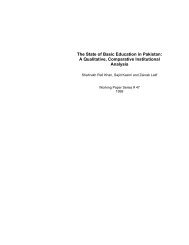
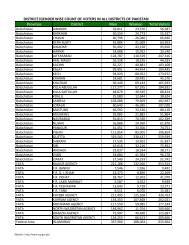
![(October - December, 2010) [13th SDC Special Bulletin]](https://img.yumpu.com/50118608/1/184x260/october-december-2010-13th-sdc-special-bulletin.jpg?quality=85)


